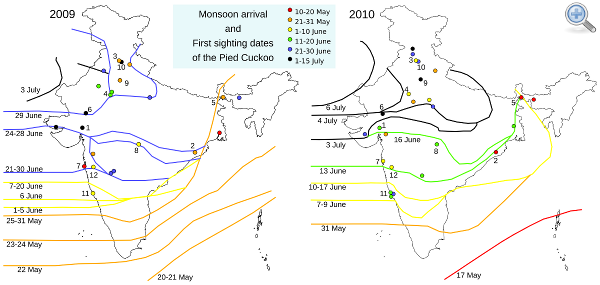Pied Cuckoos and the monsoon: 2009 & 2010
By Suhel Quader and Uttara Mendiratta from the MigrantWatch team
In 2010 we continued the Pied Cuckoo Campaign, an effort started in 2009 to gather data that would help understand the association between the southwest monsoon and arrival of the migratory population of the Pied Cuckoo to the Indian subcontinent from Africa.
Many people believe that the arrival of the Pied Cuckoo precedes the onset of the monsoon by 1–2 weeks. Is this indeed the case? The Pied Cuckoo campaign was started precisely to answer this question.
Mousumi Dutta, a MigrantWatch participant who works for the Indian Meteorological Department presented an analysis of the 2010 Pied Cuckoo data earlier on this blog; and a year and a half ago, we summarised the findings from the first season of the Campaign.
In this post, we compare the 2009 and 2010 sightings of this species in relation to the onset of the monsoon in these years. (For details of how we filtered and analysed the data, see Details, below.)
The monsoon in 2009 and 2010
The ‘normal’ onset of monsoon on the Kerala coast is 1 June. In 2009, the monsoon arrived 9 days earlier than this; and in 2010, it arrived 1 day earlier than normal. After the onset, cyclones disrupted the normal progress of the monsoon in both years. In 2009, a cyclone in the Bay of Bengal slowed the monsoon’s progress despite an early start across southernmost India, West Bengal, and the northeastern States. In the beginning of June 2010, cyclone ‘Phet’ in the Arabian Sea brought rain to parts of western India, but delayed the northward progress of the southwest monsoon.
Pied Cuckoo sightings in 2009 and 2010
Between 1 May and 15 July, the number of sightings of the Pied Cuckoo reported to the MigrantWatch database was 28 in 2009 and 25 in 2010.
Despite the earlier arrival of the monsoon in 2009 than in 2010, the first sightings of the Pied Cuckoo were on similar dates in both years (17 May and 18 May from Kolkata and Alibag respectively in 2009; and 16 and 17 May from Bhubaneswar and Jalpaiguri respectively in 2010).
First sightings are shown in relation to monsoon arrival in the maps below. These maps show ‘isolines’ (connecting locations with similar monsoon arrival dates) that depict the approximate advance of the monsoon in the two years (simplified and redrawn from maps issued by the Indian Meteorological Department). The coloured points show the locations and first sighting dates of Pied Cuckoo reports submitted to the MigrantWatch database. Twelve of the points have numbers beside them – these are locations for which first sighting dates are available for both 2009 and 2010. These points are: 1-Ahmedabad, 2-Bhubaneswar, 3-Chandigarh, 4-Jaipur, 5-Jalpaiguri, 6-Mount Abu, 7-Mumbai, 8-Nagpur, 9-New Delhi, 10-Panchkula, 11-Pilerne (Goa), 12-Pune.
To examine more closely the relationship between monsoon arrival date and Pied Cuckoo sightings, we show a scatterplot of the relationship below. Each point represents a location for which we have both the first sighting date and the approximate monsoon arrival date (taken from the IMD maps). If a point falls on the solid diagonal line it would mean that Pied Cuckoos were sighted on the date of monsoon arrival at that location; if on the dashed line, 5 days before; and if on the dotted line, 30 days before the monsoon arrived. So, if Pied Cuckoos are good at anticipating the monsoon, we would expect the points to march from the lower left to the top right of the plot. If you click on this graph you will see a larger version, on which twelve points are numbered just as in the map above.
|
Details All records of Pied Cuckoo sightings in the database can be viewed and downloaded here. The analysis and discussion presented here pertains only to sightings North of 15º N latitude, as sightings from South of this line are likely to belong to the resident population of this species. (All 28 reports of Pied Cuckoos from December to April in 2009/10 and 2010/11 come from the four southern states, and all below 13.4º N latitude.) We’ve also only used sightings from between 1 May and 15 July for both years. And when there were multiple sightings for a location, we used only the earliest sighting for that location. Caveats and improvements Data and Analysis If you wish to check how exactly the data were processed to arrive at the scatterplots above, take a look at these three files: The data downloaded on 30 April 2011 from the MigrantWatch database using a general Pied Cuckoo search; the monsoon arrival dates; and the R script used to process the raw data and generate the scatterplots. For more information on R, see www.r-project.org. After the plots were outputted from R, we made small stylistic improvements in Inkscape. |
The maps and scatterplots suggest that the degree to which the arrival of Pied Cuckoos precedes the monsoon is highly variable. Sometimes the earliest sighting is no more than a few days before the monsoon arrives, and sometimes the earliest sighting precedes the monsoon by more than 30 days. So Pied Cuckoos often do arrive at a location before the monsoon does, but the degree to which they do so varies with location and year.
Let’s look at the 12 sites for which we have first sighting dates in both years. The monsoon arrival dates and the first sighting dates from these sites are shown below, with points from 2009 in black and those from 2010 in red. The points for a single location are joined by a line to show how the arrival of the monsoon changed in the two years; and consequently how Pied Cuckoo sighting dates changed. Again, the numbers correspond to the numbered locations on the maps, above.
To help interpret this graph, the two asterisks joined by a dashed line show what one would expect for a hypothetical situation in which the Pied Cuckoos adjusted their arrival perfectly with changes in monsoon arrival — we would see a line pointing upwards from left to right. (For a more comprehensive pictorial and verbal description for how to examine this graph, click here.)
What do we see in the actual data? Out of the 12 locations for which we have information, 6 lines point upward and 6 downward, which means that cuckoos appear to show no consistent differences in arrival date with differences in monsoon onset!
Does this mean we have to revise our dearly-held beliefs about the impeccable timing of Pied Cuckoo migration? Let us know your thoughts in the comments.
Acknowledgements: The most important people in creating this report, as in all of MigrantWatch, are the participants who contributed their time and effort in reporting sightings to the database. This link lists all those whose sightings of Pied Cuckoos between May 2009 and April 2011 were uploaded to MigrantWatch. MO Anand helped in various ways with the preparation of this report. We are grateful for comments from Umesh Srinivasan and R. Jayapal.




Rajesh Kapadia says:
May 15th, 2011 at 11:31 am
Very comprehensively and meticulously done. Being a meteorologist, and a birder, its easy to understatnd, that from the weather point of view, there can be only a very “approximate” relation. I mean, you cannot rule on and totally say the arrival of the pied cuckoo will bring in the SWM tomorrow. Things from the meteorological aspect can change suddenly, like a cyclone or a low pressure system. Sure, the bird has wisdom, and rules out these hardships and arrives earlier if it can.
Regards, Rajesh.
Sreekanth says:
May 31st, 2011 at 11:40 am
Great piece of research. Indicates the kind of interesting work we could do in SeasonWatch too…
When I looked at the analysis more closely what I understood is that
1. this only makes the weaker point that the data doesn’t show that first sighting of the Pied Cuckoo is a week or two before the arrival of the monsoon. It doesn’t make the stronger point that the data disproves this (which is typical I guess in most cases?).
2. Also more points being below the line (Fig. 2) shows that in general the Pied Cuckoo does arrive before the monsoon more often than not. So there is some sense in which it is ordinally true but we cannot establish a cardinal relation. Is that the case? As the monsoon arrived earlier in 2010 expecting that the line joining the dots will move up and to the right is again expecting some kind of a cardinal relation. Ordinally still what matters is whether the dot was to the right or left of the central diagonal line (equating the sighting date to the arrival date). And most dots in either year were below the diagonal line.
So from this data, it could be still be true that they continue to arrive before the monsoons. However this does indicate that the sighting seems to be more static and seem unaffected by the monsoon having come later in 2010 than in 2009.
md azam khan says:
June 1st, 2012 at 8:02 pm
hi. spotted a pied cuckoo in early april and on 2nd may at (vil) kumera , (mandal) chevella , (dist) ranga reddy about 40 km from hyderabad
Rajeev Shukla says:
July 9th, 2012 at 4:22 am
Pied cuckoo is sighted in village Nimchaina Distt- Sitapur on 23-24 June 2012. I was told that it use to come in this season for many years .
snehal dapke says:
August 21st, 2012 at 6:56 pm
I want to join migrant watch.Pl allow me
admin says:
August 22nd, 2012 at 6:11 am
Dear Snehal, you are very welcome to join. You can sign up at
http://www.migrantwatch.in/register.php
We look forward to your participation!
Suhel
snehal dapke says:
July 30th, 2013 at 2:25 pm
pied cuckoo spotted in Suraburdi dist. Nagpur on 27-7-2012
Patrick David says:
August 1st, 2014 at 10:41 am
Though the exact timing of the arrival of the cuckoos is not in sync with the arrival of the monsoon, they more or less arrive before the SW monsoon starts. Hence, they can still be called Monsoon birds.
It would be interesing if you can upload an article about their distribution and habitat in East Africa and what triggers their movement away from East Africa into India
admin says:
August 1st, 2014 at 3:27 pm
Good idea! I don’t think that much is known about their movement away from Africa, but will see what we can find. Many thanks — Suhel (for MigrantWatch).